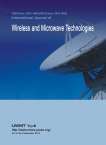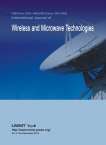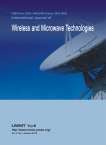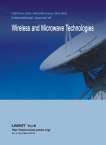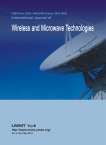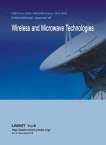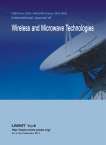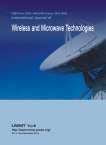International Journal of Wireless and Microwave Technologies @ijwmt
Статьи журнала - International Journal of Wireless and Microwave Technologies
Все статьи: 574

Crash Recovery for Embedded Main Memory Database
Статья научная
In the last years, the deployment of embedded real-time communication systems has increased dramatically. At the same time, the amount of data that needs to be managed by embedded real-time main memory databases is increasing, thus requiring an efficient data management. However, system crash will cause data loss in main memory, which will seriously affect the normal operation of the entire communication system. This paper introduces an algorithm of system crash recovery applied in main memory database of embedded real-time communication system. This paper expatiates the software architecture of SDR base station, the cause of crash occurring, and proposes the flash recovery algorithm using for system recovery. A main memory database using this algorithm has been applied in a real communication system——multimode SDR base station communication system.
Бесплатно
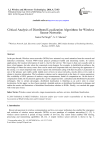
Critical Analysis of Distributed Localization Algorithms for Wireless Sensor Networks
Статья научная
In the past decade, Wireless sensor networks (WSNs) have attracted very much attention from the research and industrial community. Various WSN based projects produced fruitful and interesting results. In various applications, the location information of node is vital for the service. The reason is that users usually need to know what happens, but also where the concerned events happen. For example, in battlefield surveillance, the knowledge of where the enemy comes from can be much more important than only knowing the appearance of the enemy, it is much important that sensors reports the information along with their location. Localization is one of the primary and widely useful middle-ware services in sensor networks, mostly allows every node to obtain its location information. The localization schemes can be categorized on the basis of various parameters like availability of GPS, presence of anchors, range measurements, model of computation etc. On the basis of computation model, the localization approaches can be categorized into: centralized and distributed localization techniques. Due to certain advantages, distributed localization is flattering as an active stem in sensor localization. In this paper, we have been reported a detailed analysis on distributed localization techniques and outline the merits and limitations of distributed localization schemes in WSNs. Finally, we conclude the paper with some open issues.
Бесплатно
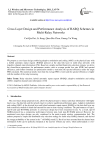
Cross Layer Design and Performance Analysis of HARQ Schemes in Multi-Relay Networks
Статья научная
We propose a cross-layer design combining adaptive modulation and coding (AMC) at the physical layer with a hybrid automatic repeat request (HARQ) protocol at the data link layer in multi-relay networks with imperfect channel state information (CSI). Based on a simple and distributed relay selection strategy, we derive the closed-form expressions for performance metrics such as average packet loss rate (PER) and spectral efficiency; and further formulate an optimization model to maximize the spectral efficiency under the target PER constraint. The numerical results show that the average PER is lower and the spectral efficiency is higher with the number of the relay increasing.
Бесплатно
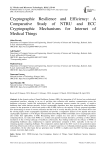
Статья научная
In the dynamic realm of Smart Healthcare Systems (SHS), the integration of IoT devices has revolutionized conventional practices, ushering in an era of real-time data collection and seamless communication across the healthcare ecosystem. Amidst this technological shift, the paramount concern remains the security of sensitive healthcare data within intricate networks. Several cryptographic algorithms have been proposed for smart healthcare systems for the protection of critical and sensitive data in SHS, however, the majority of newly proposed algorithms have shortcomings in terms of resource utilization and the level of security that they provide. Our research delves into the existing highly secure cryptographic algorithms and provides a comparative analysis of two popular and secure cryptographic algorithms viz N-th Degree Truncated Polynomial Ring (NTRU) and Elliptic Curve Cryptography (ECC) and verifies their applicability in SHS. Recognizing ECC's compact key sizes and its vulnerability to quantum computing threats, our study finds NTRU as a resilient and quantum-resistant alternative, providing a robust defense mechanism in the evolving landscape of healthcare cybersecurity. Key findings underscore the efficacy of NTRU in safeguarding healthcare data, emphasizing its superior performance compared to ECC, especially in the face of emerging quantum computing challenges. The comparative analysis depicts that ECC excels in key generation speed, delivering efficient and swift key creation. However, it requires larger keys to withstand potential quantum computing vulnerabilities. On the other hand, the key generation time in NTRU is slightly more than ECC but being quantum-resistant, it provides high security.
Бесплатно
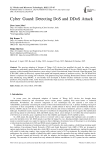
Cyber Guard: Detecting DoS and DDoS Attack
Статья научная
The growing adoption of Internet of Things (IoT) devices has amplified the need for robust security mechanisms, particularly against Denial of Service (DoS) and Distributed Denial of Service (DDoS) attacks. This paper proposes a deep learning-based detection system using a hybrid Convolutional Neural Network–Gated Recurrent Unit (CNN-GRU) model to effectively capture both spatial and temporal patterns of malicious activity. The CICDDoS2019 dataset is employed for training and evaluation, with preprocessing steps including Boruta-based feature selection and data rebalancing using SMOTE. A user-friendly GUI developed in Python (Tkinter) facilitates real-time input and prediction. The proposed model, Cyber Guard, demonstrates high accuracy and efficiency, offering a practical solution for IoT attack detection and future deployment.
Бесплатно

Cyber-resilient Routing for Internet of Vehicles Networks During Black Hole Attack
Статья научная
The ever need for transportation safety, faster and convenient travel, decrease in energy consumption, as well as inter-connectivity has led to the field of intelligent transportation system (ITS). At the core of ITS is the Internet of Vehicles (IoV) combining hardware/sensors, software, and network technologies. Vehicular ad hoc networks (VANETs) create mechanisms to connect IoV main elements, including vehicle-to-vehicle (V2V), vehicle-to-infrastructure (V2I), and Vehicle-to-Sensors (V2S). ITS systems heavily rely on its network connecting different parts of its infrastructure and ensuring data exchanges. However, VANET security is one of the primary challenges faced by connected vehicles. In IoV, the network is accessed by a variety device making the system vulnerable to a multitude of malicious attacks, including distributed denial-of-service (DDoS) and black hole attacks. Since critical vehicle systems can be accessed remotely, successful attacks can lead to fatalities. In VANET, any node can function as a router for the other nodes, therefore a malicious node connected to the network may inject spoofed routing tables to the other nodes thereby affecting the operation of the entire network. To overcome this issue, we proposed a security scheme designed to improve routing protocols in the detection of black hole attack. The proposed approach is demonstrated on a Network Simulator (NS3.27) using different network parameters such as average packet loss rate, end-to-end delay, packet delivery ratio (PDR) and network yield. Simulation results demonstrate the proposed method adds 10-15% improvement (on average) in End-to-End Delay, Packet Delivery Rate, Packet Loss Rate and Network Yield as compared with conventional Greedy Parameter Stateless Routing and Path Aware Greedy Parameter Stateless Routing under the black hole attack.
Бесплатно
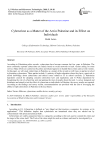
Cybercrime as a matter of the art in Palestine and its effect on individuals
Статья научная
According to Palestinian police records, cybercrimes have become common last few years in Palestine. The most commonly reported cybercrimes are mainly based on social networks to hack victims asking for some service. Many efforts are carried out by police and related agencies to handle these crimes and save the victims. In this paper, we will study cybercrimes in Palestine as a matter of the art and we will focus on parties involved in thwarting cybercrimes. These parties include: 1) ministry of higher education where they have a great role to afford knowledge about cybercrimes and ethical issues related to IT in school curricula. 2) Palestinian legislative council for adopting concrete cybercrime laws and regulations. and 3) Police department by broadening the role of cybercrime unit and gaining the trust of people about that unit. A survey designed and distributes and aimed to test the effect of cybercrime on individuals in Palestine, the survey results are reported. According to the findings and survey results, recommendations are provided with the aim of leveraging the ability to fight cybercrimes in Palestine in the near future.
Бесплатно
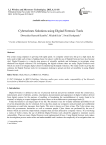
Cybercrimes Solutions using Digital Forensic Tools
Статья научная
The crimes using computers is growing with rapid speed. As computer crimes have hit up to a high mark, the tools used to fight such crimes is budding faster. In today's world the use of Digital Forensics have also become vital. Digital Forensics is a step-by-step process of scientific methods and techniques to investigate crime obtained from digital evidences. For investigating the digital evidence there are many Digital Forensic tools which are used to investigate digital crimes by identifying the digital evidences. The study results in giving the solutions for Digital Forensic tools for investigators looking to spread out their serviceability in using Digital Forensic tools.
Бесплатно

Статья научная
The digitalization of aviation has heightened exposure to cyber risk, yet Philippine aviation governance and practice remain fragmented. This study evaluates sectoral vulnerabilities and feasible mitigations using a multi-method design: (i) document analysis of CAAP circulars, DICT’s National Cybersecurity Plan 2022, and international guidance (ICAO, IATA, NIST, ISO/IEC 27001); (ii) case studies (Cathay Pacific breach; London Heathrow USB mishandling) chosen for analytic transferability to Philippine operations; and (iii) risk modeling via a likelihood–impact matrix with a transparent 1–5 rubric adapted from ICAO SMM, NIST SP 800-30, and DICT, scored independently by two researchers with consensus reconciliation. I integrate results through a SWOT–TOWS synthesis and propose an AI/ML feasibility roadmap tailored to on-prem/air-gapped constraints. Findings reveal high-priority risks, including unauthorized ATC access, reservation-system data breaches, and airport-network ransomware (ris score = 20), driven by monitoring gaps, legacy systems, and uneven policy enforcement. Moderately ranked threats (weak framework implementation; phishing) and under-analyzed insider risk reflect systemic and human-factor weaknesses, compounded by underreporting and limited inter-agency coordination. The study’s novel contribution is a localization map that operationalizes global frameworks for Philippine conditions: phased NIST CSF adoption, tiered ISO/IEC 27001 pathways, and ICAO-aligned CAAP–DICT coordination with centralized incident reporting; plus a staged, low-cost AI/ML roadmap with KPI tracking (MTTD/MTTR, precision/recall). Limitations include the absence of primary stakeholder data and local incident/cost series; we outline a quantitative extension using operator surveys and Expected Annual Loss modeling to strengthen future empirical grounding. The results inform regulators, airlines, and airports on risk-based prioritization and practical governance upgrades to enhance national aviation cyber resilience.
Бесплатно
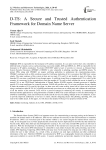
D-TS: A Secure and Trusted Authentication Framework for Domain Name Server
Статья научная
DNS is responsible for the hostname to IP address translation. It is an open resolver that's why vulnerable to different kinds of attacks such as cache poisoning, man-in-the-middle, DOS and DDOS, etc. DNS is responsible for the hostname to IP address translation. To protect DNS IETF added a layer of security to it known as Domain Name System Security Extensions (DNSSEC). DNSSEC is also vulnerable to phishing, spoofing, and MITM attacks. To protect DNS, along with DNSSEC we require certifying authorities to authenticate the communicating parties. DNSSEC combined with an SSL certificate issued by Certifying Authorities (CA's) can protect the DNS from various attacks. The main weakness of this system is there are too many CA's and It is not feasible to trust all of them. Any breached CA can issue a certificate for any domain name. A certificate issued from a compromised CA's is valid. In this scenario, it is necessary for the organization to limit the number of CAs and to check whether the server is signed by a trusted CA's or not. DNS Based Authentication of Named Entities (DANE) permits a domain possessor to stipulate specific CA's issue certificates for a specific resource. DANE will not allow any CA to issue certificates for any domain. It limits the number of CA's used by the client. As there were still some security issues left in it that can be resolved using a mechanism called D-TS. It is a DANE-based trusted server that acts as a third party and validates the certificates of all the entities of the network. D-TS will be a proof-of-concept for enhancing the security in communications between Internet applications by using information available in DNS. The system attempts to solve the shortcomings of DANE by establishing a trust zone between the clients and the services. By adding multiple levels of validations, it aims to provide improved authenticity of services to clients, thereby mitigating attacks like phishing, Spoofing, Dos, and man-in-the-middle attack. In this paper, we will discuss the detailed working of our proposed solution D-TS.
Бесплатно
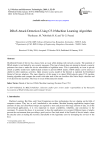
DDoS attack detection using C5.0 machine learning algorithm
Статья научная
Distributed Denial of Service has always been an issue while dealing with network security. The potential of DDoS attacks is not limited by any security measures. This type of attack does not attempt to breach a security perimeter but aims to make the service unavailable to legitimate users. This is particularly an issue in private clouds as public clouds have sophisticated systems to prevent DDoS attacks. DDoS attacks can be used as a shield for other malicious activities. Open resource access model of the Internet is exploited by Distributed Denial of Service attackers. The main objective of this paper is to detect DDoS attacks using C5.0 machine learning algorithm and compare the results with other state of the art classifiers like Naïve Bayes classifier and C4.5 decision tree classifier. The focus is on an offline detection model.
Бесплатно
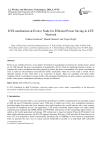
DTX mechanism at Evolve Node for Efficient Power Saving in LTE Network
Статья научная
Power in any cellular network is a key degree of freedom in management of connectivity, energy factors, speed etc. In LTE network the power consumption is dominated by Evolve Node by significant amount of power, to compute this issue a mechanism has been proposed to reduce the power consumption. The power consumption issue is tackle by Discontinuous Transmission (DTX) mechanism where the evolve node is switch off for specified amount of time when there is no occurrence of packet. These are simulated with busty traffic condition which is considered to poison traffic with exponential distribution for delay sensitive and insensitive traffic, where power consumption and latency average is calibrated.
Бесплатно

